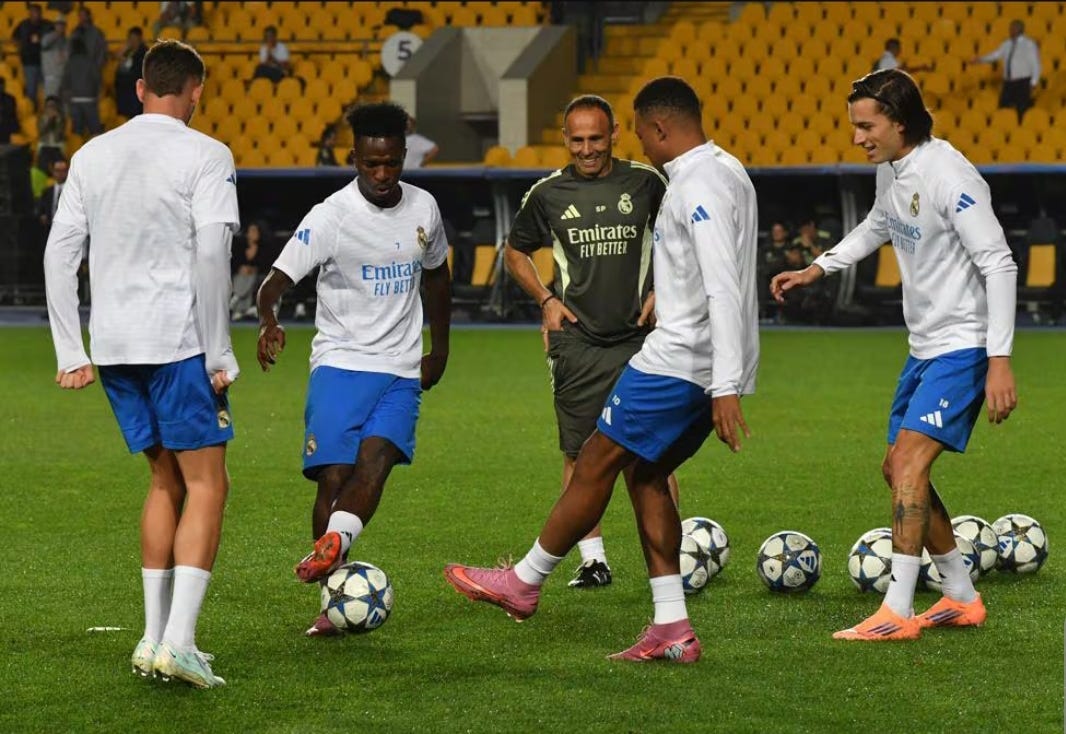Real Madrid aims to return with all three points from Kairat Almaty’s stadium in Kazakhstan in the second round of the UEFA Champions League on Tuesday. After their 2-1 victory over Marseille in the first round, achieving their 200th win and 700th goal in Champions League history, the team enters a new match facing unconventional challenges. They seek to maintain their smooth and balanced attacking style while simultaneously adapting to the absence of key players or the reduced readiness of some important squad members. In this analysis, we explore the best possible lineup for the encounter and the most suitable tactical plan considering the team’s dynamics, taking into account offensive and defensive flexibility and rapid transitions that could decide the match.
Xabi Alonso’s Challenges
Coach Xabi Alonso, who is accustomed in La Liga to flexibility and experimentation, finds himself forced to redraw plans and lineups against a team that may appear easy on paper but is tactically unknown on the field. The need for change is not just an option but a necessity; players who have not delivered the expected performance, such as Tchouaméni, or those who have not fully regained their fitness, like Bellingham, represent potential weak points. Conversely, the presence of certain players, such as Fede Valverde, remains necessary despite a relative decline in their performance, particularly in specific positions due to the absence of Carvajal and Trent. All of these factors make the lineup more than just a selection of names; it is a precise balancing act between defense and attack, between flexibility and discipline, and between maintaining attacking fluidity and minimizing defensive gaps.
Defense: The Adaptation Test
The defensive line will be an important test of Real Madrid’s ability to adapt. Valverde will take the right-back position, which is not his usual role, but it is the most suitable choice in the absence of Carvajal and Trent. He has previously proven himself in this role during Ancelotti’s tenure. He excels in carrying the ball forward, supporting attacks, and quick transitions, but he requires full defensive concentration to avoid gaps, which he emphasized ahead of the match against Kairat Almaty.
In central defense, Asensio and Dean Huijsen are expected to feature. Asensio is a necessary option due to the absence of Rüdiger and Militão, possessing strong coverage abilities and precise interventions when fully focused, while Huijsen adds defensive stability and skill in reading counterattacks, even though his performance in the recent derby was below his usual level. The left-back, Fran García, balances offensive support and defensive coverage and allows Carreras to rest after his continuous participation.
Midfield: The Control Hub
The midfield is the heart of controlling the rhythm of the game; Camavinga will be the backbone, with his ability to dribble, make smart passes, and release the ball under pressure, making him the most suitable to take the position of Tchouaméni, who did not perform with the same strength in the derby. Alongside him, Ceballos provides defensive balance, with his ability to intercept passes and handle direct pressure, making him a better option than Bellingham, who has not fully proven his readiness since returning from injury.
Arda Güler, in the advanced playmaker role, offers Real Madrid a unique dimension in building attacks. He is a player gifted with excellent ball control under pressure and sharp vision for passes that break defensive lines. Positioned just behind Mbappé, he can exploit the tight spaces between Kairat’s midfield and defensive line, giving the team greater variety in chance creation. Güler is not limited to passing; he also possesses the ability to shoot from distance, adding an extra attacking weapon that could unsettle the opposition defense, which may already be occupied with marking Vinícius and Mbappé on the flanks.


